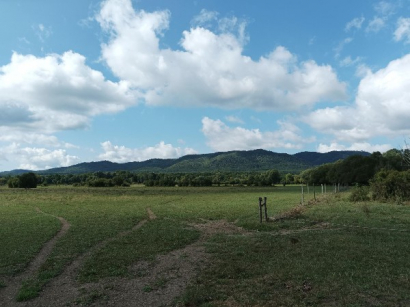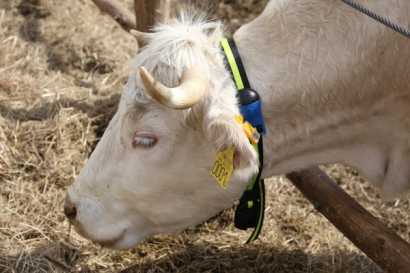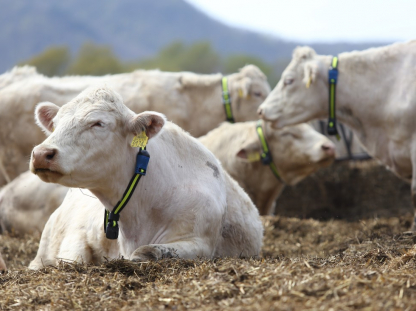Digital solutions in the grazed cattle sector
or how to get much more useable, practical data, at a time when the number of agricultural labourers is declining
We warmly welcome readers to the launch of our new series exploring an ÖMKI research project, in which we are trying to help solve the increasingly serious problem indicated above. Figuratively speaking, we want to make the invisible visible, so that:
- we know what is happening out in the pasture,
- we know how our animals are feeling,
- we are able to intervene promptly in cases of, for instance, illness,
- we can see when a pasture is “used up”, and the animals have to be moved – even if we can't get out to see them for a few days,
- we can get freshly updated, daily data about the animals, based on which we can learn more about their behaviour, habits, and the effects of our husbandry.
The aim of all this is to ensure that, through continual observation and the timelier interventions which this enables, we can ensure both the highest standards of animal welfare and the most efficient possible production.
It would be wonderful if every herder had several experienced assistants who had a profound understanding of the animals. However, as the workforce in this sector continues to shrink, this is becoming an increasingly unrealistic ideal. In addition, most new entrants have little or no experience in animal husbandry, as they usually transfer from other sectors. Unfortunately, we are also witnessing the slow disappearance of animal herding “dynasties”. As if this were not enough, we may add that animals are often now bred for a genetic profile that favours intensive husbandry, while the changing environment and climate mean that herders must not only find ways to adapt, but must also abide by the sustainability requirements set for animal husbandry.
It is in this challenging situation that digitalization has emerged in agriculture, including miniaturized and increasingly powerful sensors, high-performance data transmission devices, large storage facilities, advanced computing capacities, and, most powerfully of all, artificial intelligence, which can transform the raw data into information and advice for improving everyday production.
Our research revolves around showing how this new toolkit, which many are both unfamiliar with and wary of, can be used to enhance animal welfare and help raise beef cattle in a sustainable manner. Our experiments are performed on-farm, in a practical environment, in Zala county, near Várvölgy, with Charolais beef cattle grazing in Natura2000 areas. Throughout this series of articles, both the location and the husbandry method will be introduced in more detail.
For us, the on-farm experiment not only means carrying out our research in an active agricultural environment, but also working with large number of animals (120 cows and their calves), i.e. at farm scale, and not just using a single sensor, giving a single perspective, but rather several different types, in order to determine which one gives the most useful information to farmers.
We only use sensors that do not disturb the animals or affect their everyday lives. We will talk about these issues in detail as well. The large number of animals is necessary in order to give us a statistically viable sample size for our calculations and analyses. By examining the entire herd, we can obtain the most accurate picture of the actual situation.
In the following section, we will provide a little more information about the background of this study, as well as outlining the benefits of digital solutions and their inevitability in today’s world. Agriculture must continuously reduce its ecological footprint, while at the same time producing adequate amounts of healthy food at an affordable price. Industrial livestock farming is not considered an ideal environment for animals, and its ecological sustainability is by no means guaranteed. We need to look for alternatives, striving to enable our animals to fulfil their natural needs (exercise, walking in the open air, practicing animal-specific behaviours) while they remaining healthy and productive.
What is precision animal husbandry?
Fundamentally, precision farming was developed to improve production results. This is true in both crop production and animal husbandry. The methods used in precision farming can also be employed in organic farming, thus helping to support environmentally conscious production and further reducing the ecological footprint of that production.
What does precision farming mean for farmers? It means getting the most accurate and up-to-date information about the animals – preferably individualized data, that is, for each separate animal – allowing the farmer to make the best possible, individually-tailored decisions on that basis. In livestock farms we tend to deal with individual data only in the most serious cases (therefore rarely), while herd and group data are considered more important. However, let us not forget that each group or herd is made up of individuals, and the sum, mean, standard deviation of the individual data is used to give us results for the group. Thus, the more accurate the individual data, the more accurate our group data will be, since the latter is the aggregated totality of the former.
Each piece of data is worth as much as the information we can get out of it!
Data is an interesting thing, a bit like a stone to the sculptor. There is a masterpiece concealed within it, you just need to chip away the excess. The data must also be processed in such a way that the maximum possible information contained within it can be accessed, since accurately collected data comprises a particular representation of the complexity of reality. The truth is there within it, as well as many things we are curious about.
Raw data cannot yet be used to help make decisions, and may not even be enough for an immediate alert. All data should be analysed in context. Such contextual elements (in dairy cows) include the age of the animal, her state of fertility, pregnancy test results, group switching, treatment, number of lactations, information from other systems, e.g. from the milking machine, and much more besides. All this should to be taken into account by the processing software, so that the most accurate correlations can be discovered and the necessary interventions can be made, in order to improve production results. Often, however, we find that precision tools and the relevant software are not in themselves sufficient to provide practically relevant information. A specialist in data analysis (and, of course, in animal husbandry) is needed to turn data and graph dumps into a useful technological recommendation.
How does the precision tool help and support animal welfare?
In a nutshell, by supplying direct feedback on how animals are coping with the environment, the pasture, the trough, and their feed, which they live by and from which they produce for us. We can receive alerts when the animal is in danger, and obtain analytical results about what is going on when we are not with the animals. Based on these results, we can intervene for the welfare of the herd, and thus improve production. We will present many examples of this over the course of this series.
ÖMKi's animal husbandry team
Further information on precision animal husbandry from other Hungarian sources:
https://www.technokrata.hu/egazdasag/digitalizacio/2021/04/03/digitalis-agrarakademia-jolet/
https://hirlevel.egov.hu/2021/06/27/indul-a-mindenki-szamara-ingyenes-digitalis-agrarakademia/



_(2).jpg)







